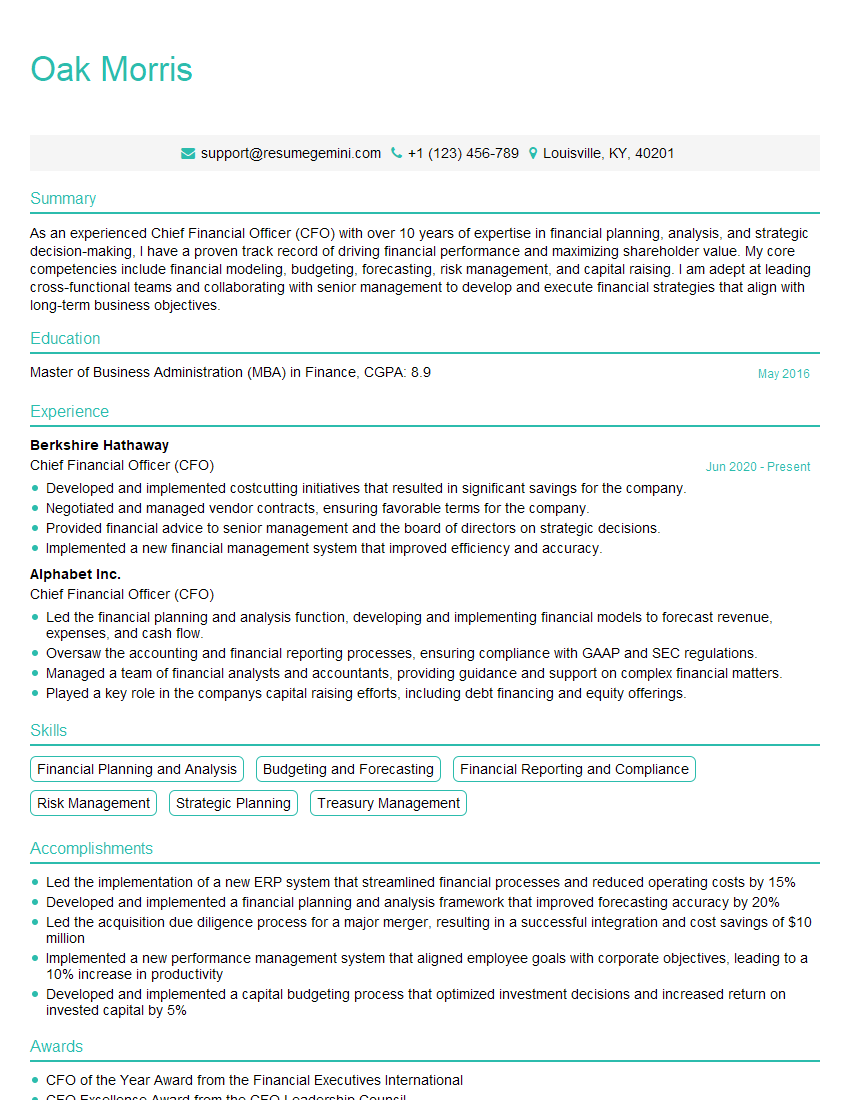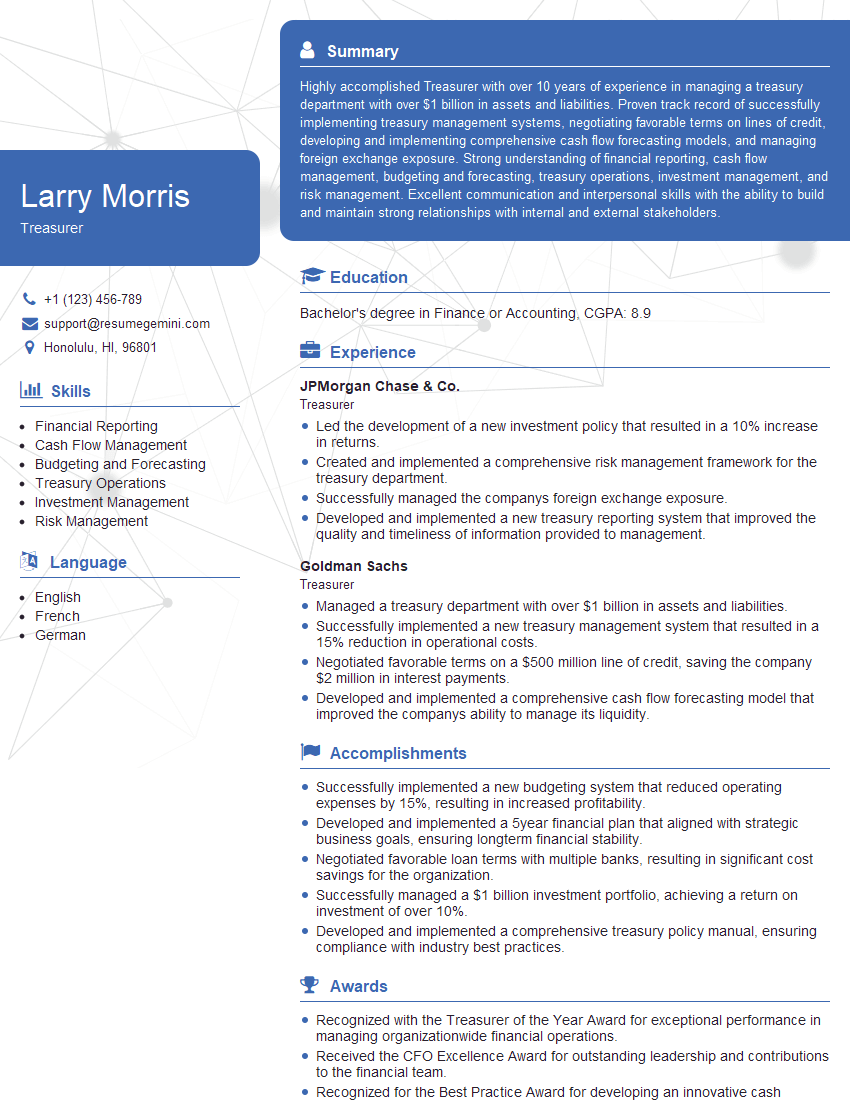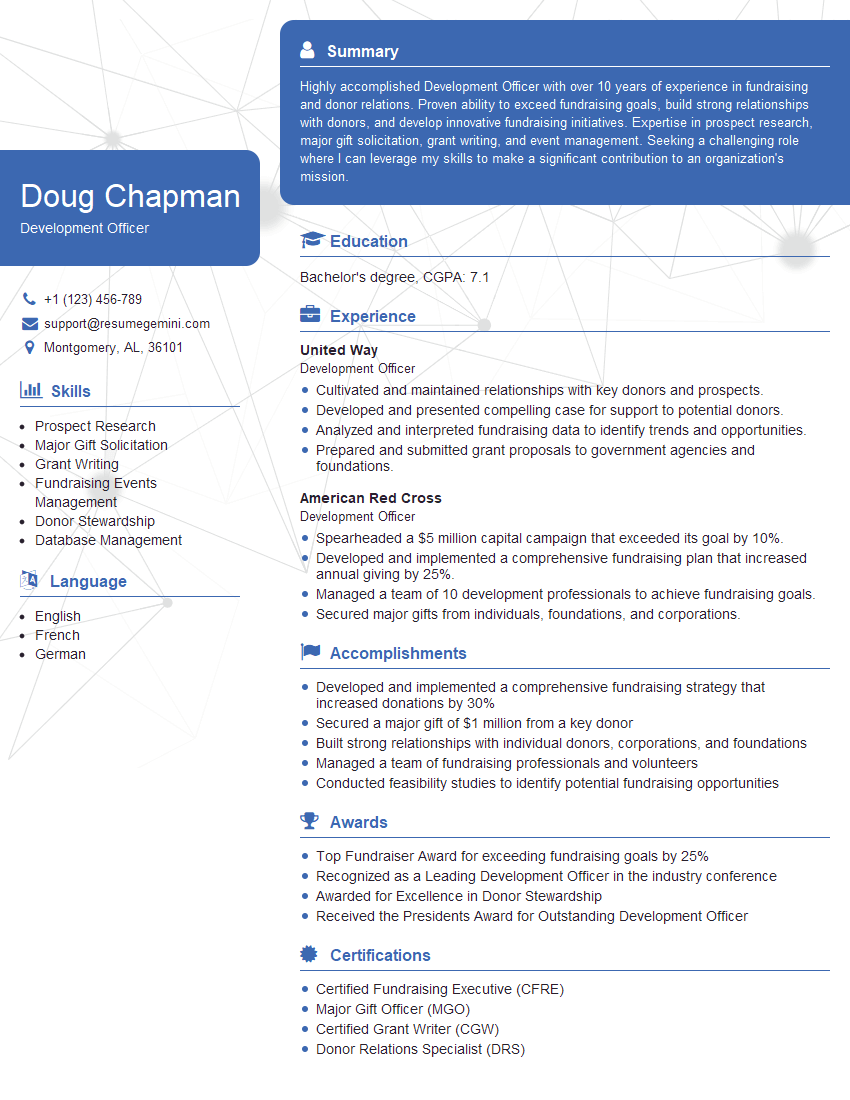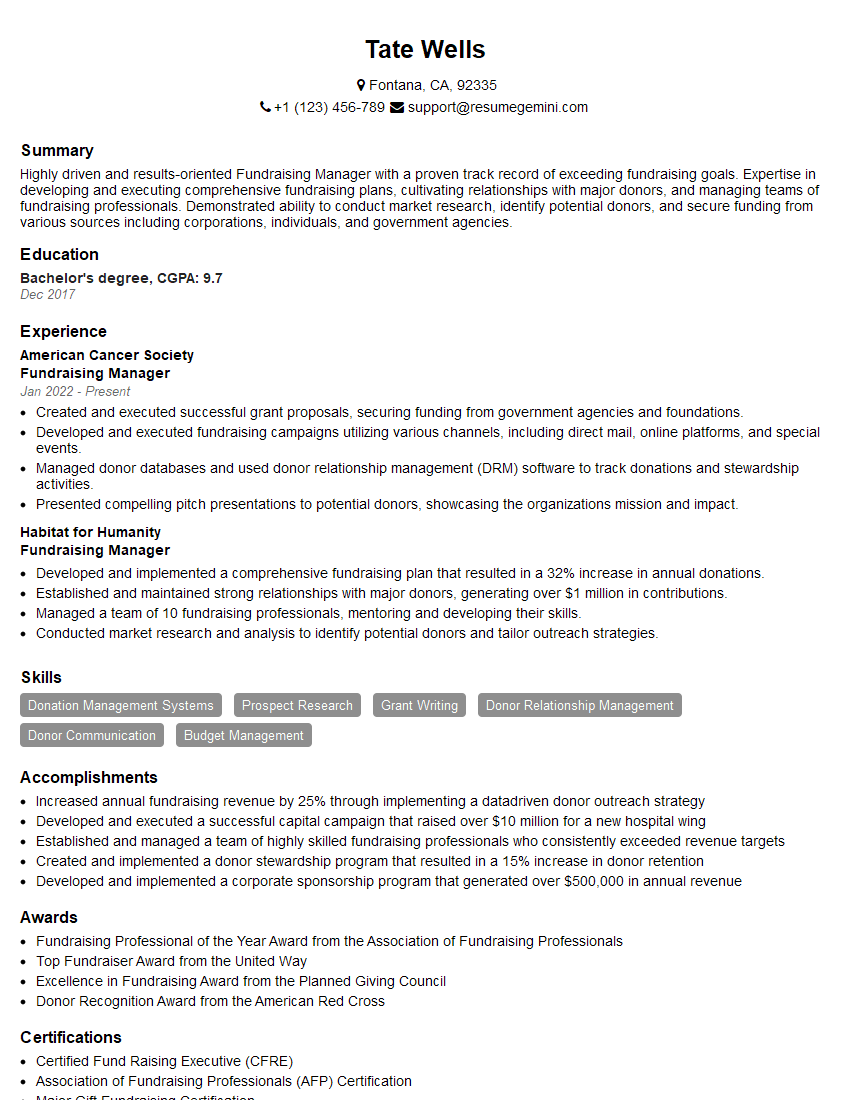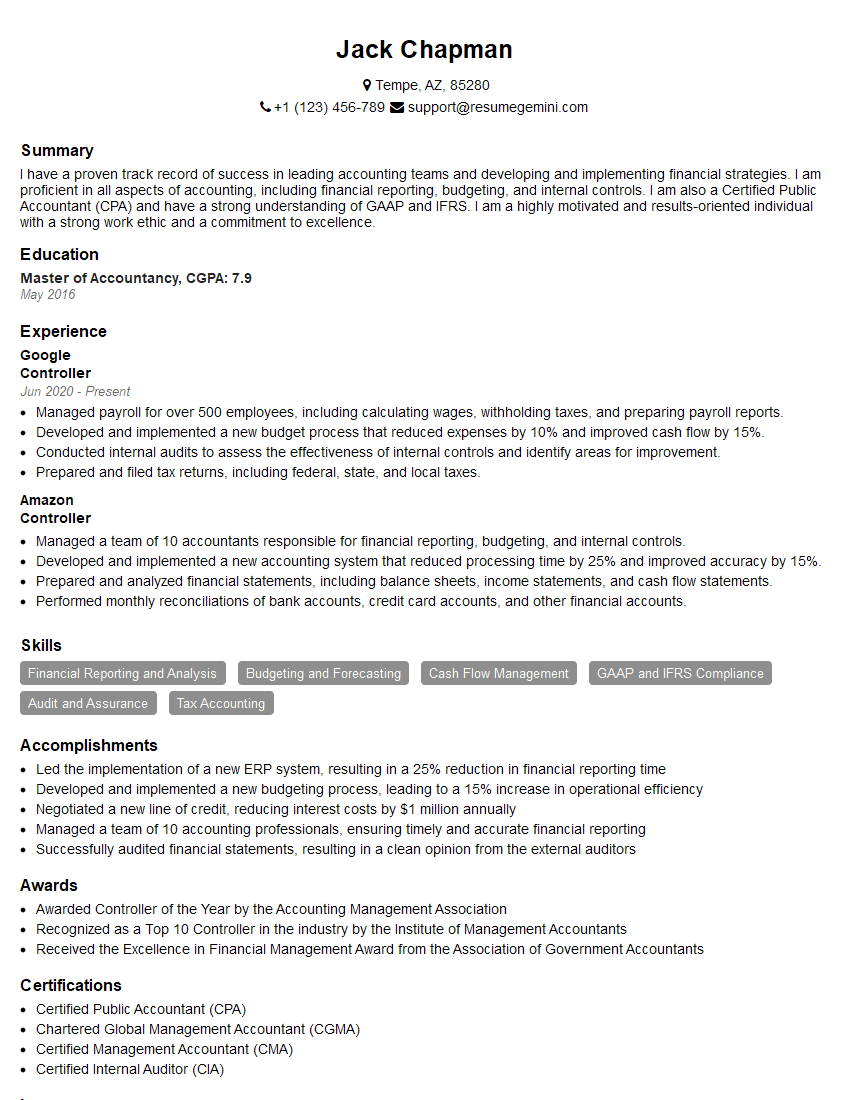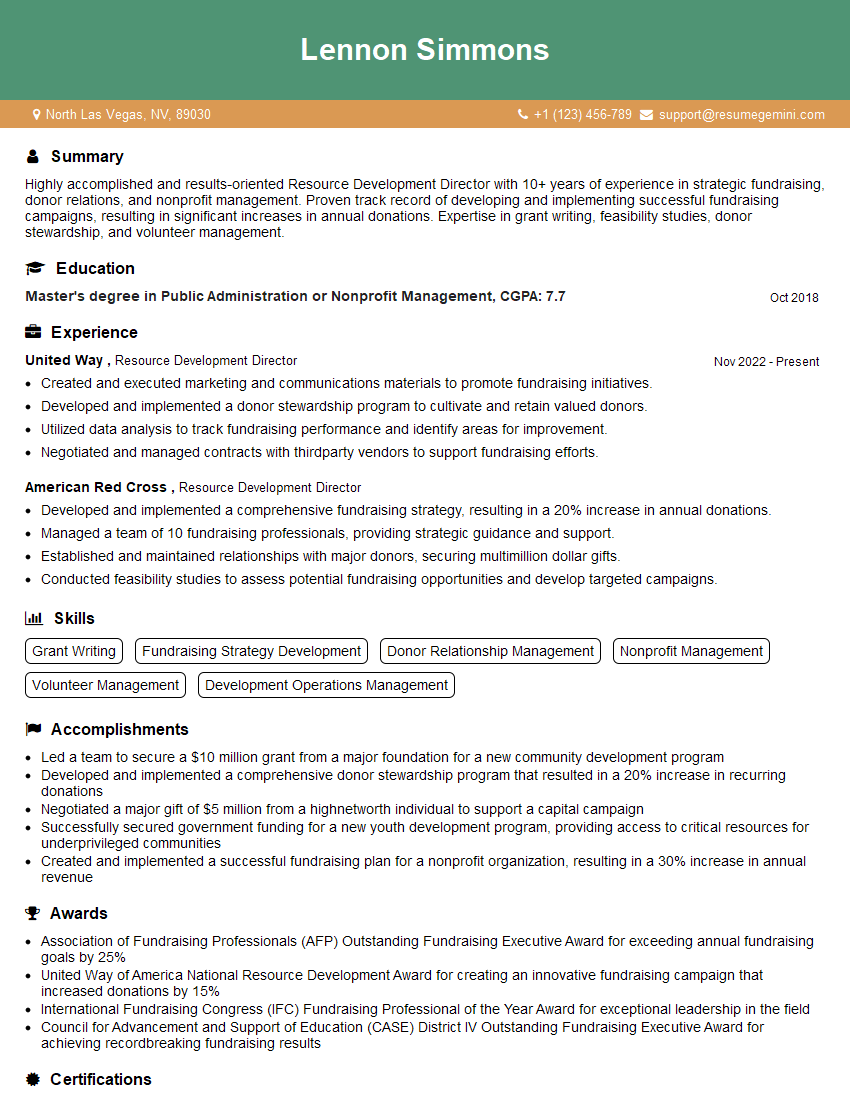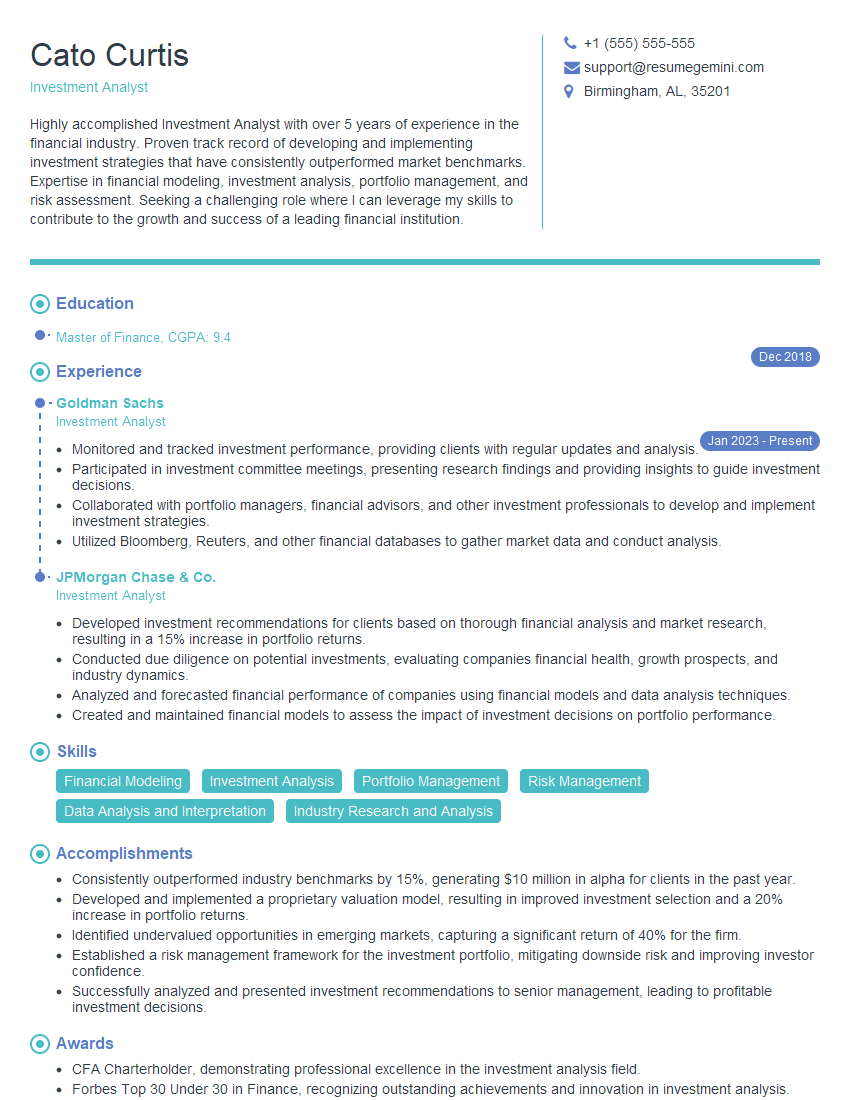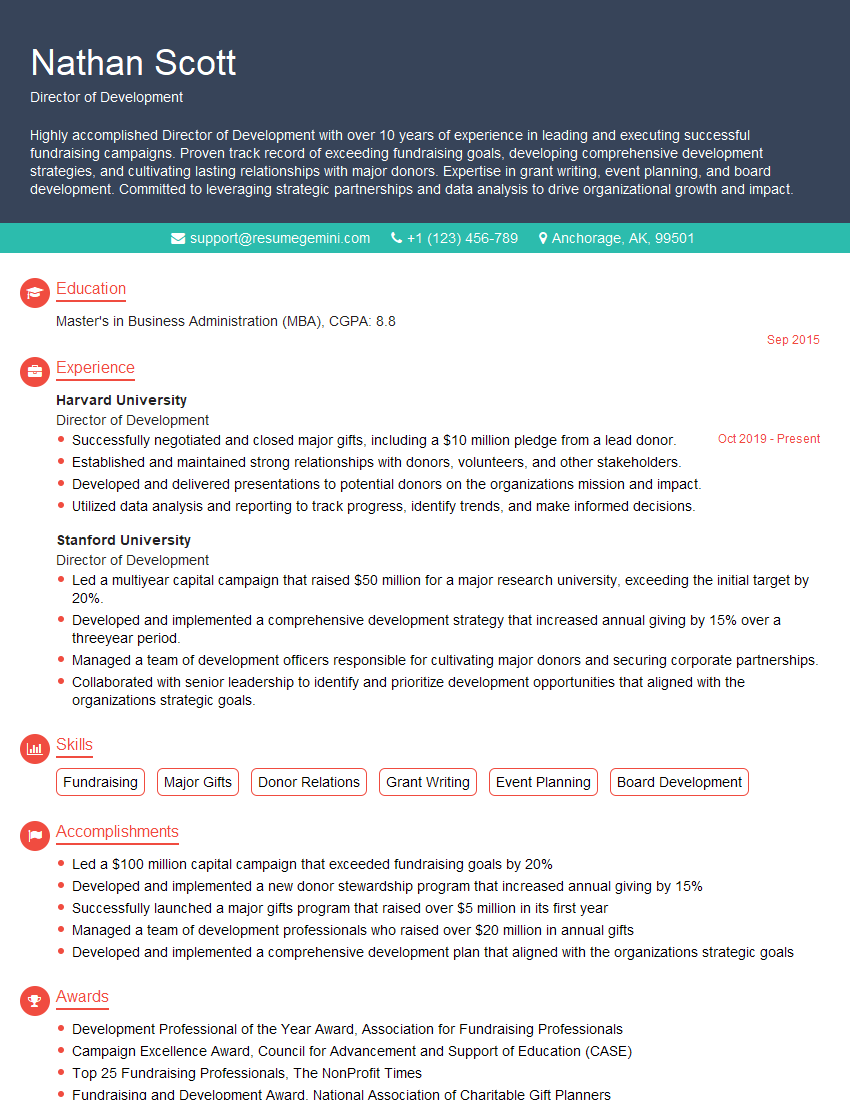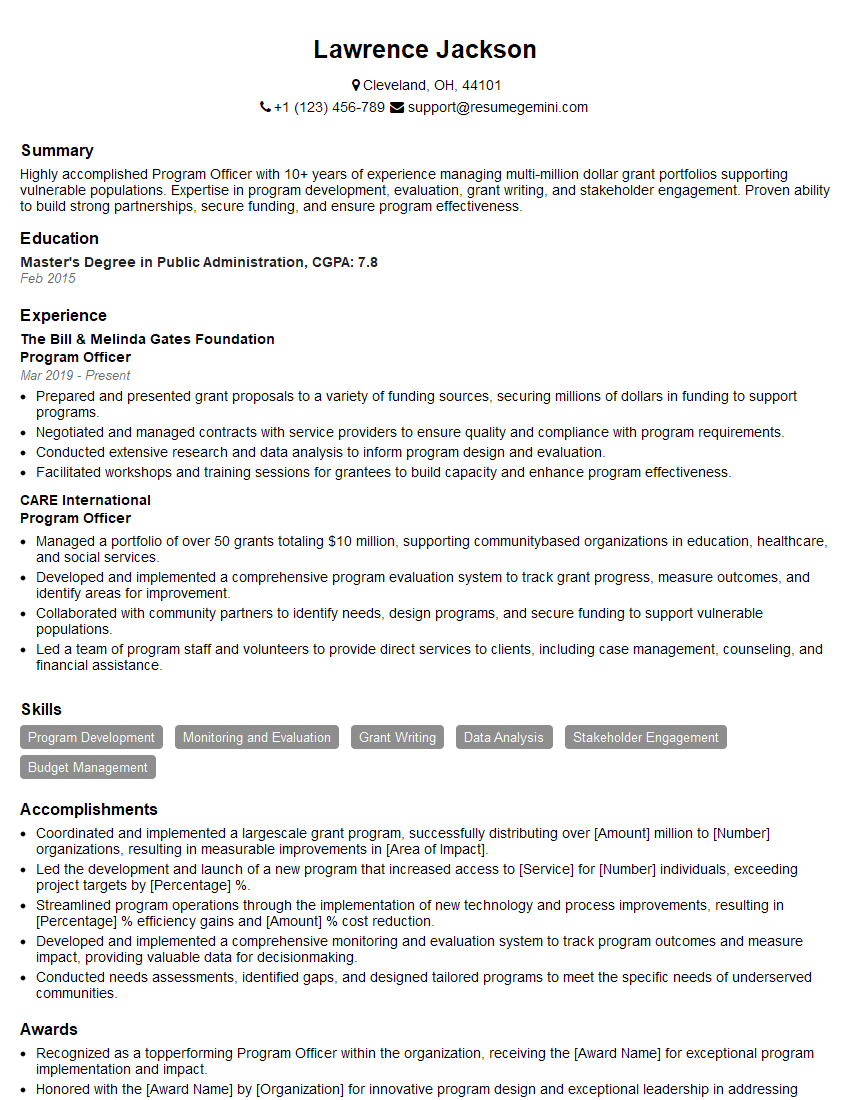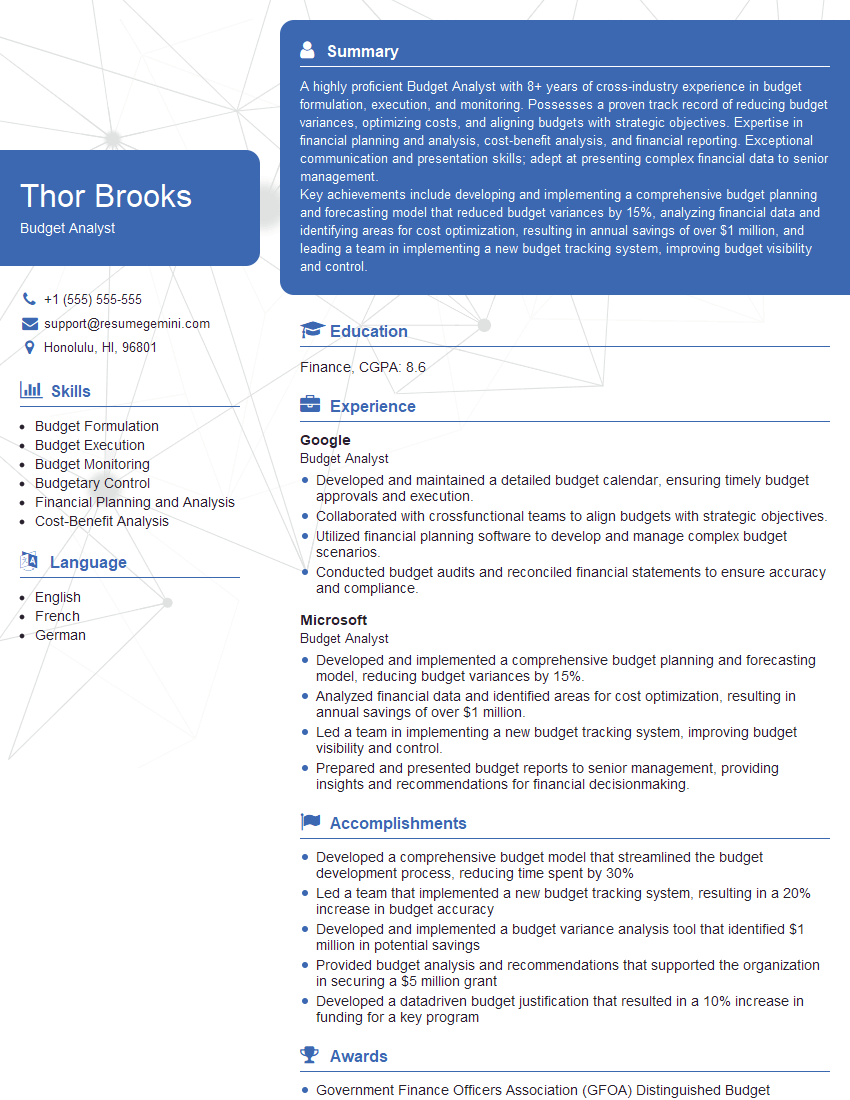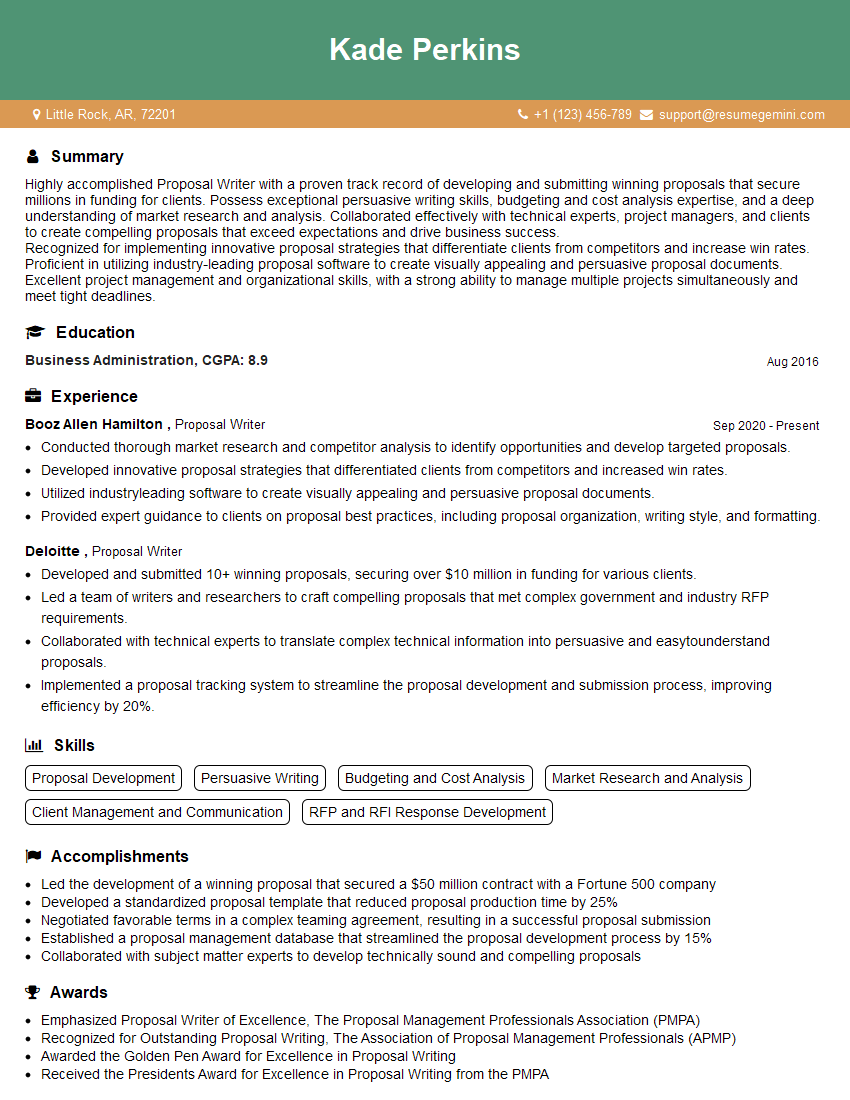The thought of an interview can be nerve-wracking, but the right preparation can make all the difference. Explore this comprehensive guide to Knowledge of different types of funding sources interview questions and gain the confidence you need to showcase your abilities and secure the role.
Questions Asked in Knowledge of different types of funding sources Interview
Q 1. What are the key differences between grant funding and venture capital?
Grant funding and venture capital are both crucial sources of external finance, but they differ significantly in their nature, purpose, and expectations. Think of grant funding as a gift, while venture capital is more like an investment.
Grant Funding: Grants are typically awarded based on merit, usually for projects with a societal benefit or aligned with the funder’s mission. They don’t require repayment and usually come with less stringent conditions than venture capital. Examples include research grants from the National Science Foundation or funding for community development initiatives from local governments.
Venture Capital: Venture capital is an investment in exchange for equity in a company. Venture capitalists invest in high-growth potential businesses, expecting a significant return on their investment through future equity appreciation or sale. They usually have considerable influence over the company’s strategy and direction. A classic example would be a tech startup securing funding from a firm like Andreessen Horowitz.
In short: Grants are non-repayable funds for specific projects; venture capital is an investment in a business for a return on equity.
Q 2. Explain the process of securing a grant from a government agency.
Securing a government grant is a multi-step process requiring meticulous planning and execution. It often involves navigating bureaucratic procedures and demonstrating a strong alignment with governmental priorities.
Identify Relevant Agencies: Begin by identifying government agencies whose mission aligns with your project’s goals. Thorough research is essential here.
Understand Funding Requirements: Carefully review the grant guidelines, eligibility criteria, and application deadlines for each potential funding source. This often includes specific reporting requirements.
Develop a Compelling Proposal: This is the heart of the application. It needs to clearly articulate the project’s objectives, methodology, budget, and expected impact. A strong narrative, demonstrating clear need and potential impact, is crucial. High-quality data and evidence supporting your claims are vital.
Submit a Flawless Application: Adherence to deadlines and formatting requirements is critical. A poorly presented application can be instantly disqualified, regardless of the merits of the project itself.
Manage the Review Process: Be prepared for questions from reviewers and be responsive to their requests. This might involve revisions to your proposal or providing additional information.
Manage Awarded Funds: If successful, rigorous tracking and reporting of the use of funds are mandatory to maintain compliance and demonstrate value.
For example, an environmental non-profit seeking funding for a reforestation project would research grants from the Environmental Protection Agency (EPA) or the National Oceanic and Atmospheric Administration (NOAA), following their specific application processes.
Q 3. Describe your experience with crowdfunding platforms.
My experience with crowdfunding platforms has been both rewarding and insightful. I’ve seen firsthand how powerful these platforms can be in connecting projects with potential backers. Platforms like Kickstarter and Indiegogo offer a diverse range of opportunities, but they also require a strategic approach.
Platform Selection: Choosing the right platform is essential. Kickstarter is known for its all-or-nothing funding model, while Indiegogo offers flexible funding options. The platform’s audience and its alignment with your project’s nature are key considerations.
Campaign Development: A well-crafted campaign page is crucial. High-quality visuals, a compelling narrative, and clear rewards are essential for attracting backers. Regular updates are vital to maintain momentum and build trust.
Marketing and Outreach: Successfully launching a crowdfunding campaign requires proactive marketing. Utilizing social media, email marketing, and public relations to reach your target audience is critical.
Community Building: Engaging with potential backers and fostering a sense of community is important. Answering questions promptly and building excitement around your project can significantly increase its success.
For example, I worked with a small artisan collective launching a crowdfunding campaign on Kickstarter for a new line of handcrafted jewelry. Through strategic marketing and community engagement, we surpassed our funding goal within days.
Q 4. How do you assess the financial viability of a project before seeking funding?
Assessing the financial viability of a project before seeking funding is paramount. A thorough financial analysis helps to determine if the project is likely to achieve its objectives and generate a return (if applicable) and demonstrates preparedness to potential funders.
Market Research: Understanding the market demand for your product or service is crucial. This involves analyzing competitors, potential customer segments, and pricing strategies.
Cost Analysis: Developing a detailed budget that includes all anticipated expenses, such as materials, labor, marketing, and overhead, is vital.
Revenue Projections: Based on market research and cost analysis, realistic revenue projections must be created. This may involve various scenarios or sensitivity analysis.
Funding Gap Analysis: Determine the difference between your projected costs and revenue. This gap will represent the funding required. This also helps to determine whether various funding models are appropriate.
Financial Modeling: Creating financial models (using tools like spreadsheets or specialized software) allows you to project cash flows, profitability, and return on investment over time.
For instance, before seeking venture capital, a tech startup would conduct thorough market research to validate their product’s demand, model future revenue streams, and build a detailed financial forecast to show investors a potential return on their investment.
Q 5. What metrics do you use to track the success of a funding campaign?
Tracking the success of a funding campaign requires a set of well-defined metrics, depending on the type of funding. These metrics provide insights into campaign performance and inform future fundraising strategies.
Crowdfunding: Key metrics include the total funds raised, the number of backers, the average pledge amount, and the overall conversion rate (percentage of website visitors who become backers). Social media engagement and press coverage can also be valuable indicators.
Grant Funding: Success is measured by the achievement of project milestones, the effective utilization of funds, and the overall impact on the target beneficiaries. This often requires detailed reporting and evaluation.
Venture Capital: Success is measured by achieving key performance indicators (KPIs) and demonstrating growth trajectory as defined in the investment agreement. Metrics might include revenue growth, customer acquisition cost, market share, and profitability.
For example, a successful grant for a community health initiative might be judged by increased access to healthcare, improved health outcomes, and the sustainability of the program after the grant period.
Q 6. What are the ethical considerations involved in securing funding?
Securing funding ethically requires maintaining transparency, integrity, and accountability throughout the process. Ethical lapses can severely damage reputation and credibility.
Transparency: Be upfront about the project’s goals, budget, and how funds will be used. Avoid misleading or exaggerating information.
Integrity: Ensure that all information presented in funding applications and reports is accurate and truthful. Avoid misrepresenting data or manipulating results.
Accountability: Maintain detailed records of how funds are spent and be prepared to provide regular reports to funders. This demonstrates responsible stewardship of resources.
Conflict of Interest: Disclose any potential conflicts of interest that could influence the funding decision. This includes any personal relationships or financial ties with funders or stakeholders.
Compliance: Adhere to all applicable laws, regulations, and ethical guidelines related to funding acquisition and management.
For instance, falsely claiming environmental benefits to secure a green grant or using project funds for unrelated purposes would be highly unethical and could lead to severe consequences.
Q 7. How do you identify potential funding sources for a specific project?
Identifying potential funding sources requires a systematic approach, beginning with a thorough understanding of your project’s needs and characteristics.
Define Project Needs: Clearly articulate the project’s goals, budget, and timeline.
Identify Potential Funders: Research organizations, foundations, government agencies, and corporations that align with your project’s mission and funding priorities. Online databases and specialized directories can be invaluable resources.
Assess Funder Alignment: Evaluate each potential funder’s grant guidelines, past funding decisions, and areas of focus to determine if your project is a good fit.
Network and Build Relationships: Attend relevant conferences, workshops, and networking events to connect with potential funders and build relationships.
Tailor Proposals: Customize your funding proposals to meet the specific requirements and preferences of each potential funder.
For example, a researcher seeking funding for a medical study might explore grants from the National Institutes of Health (NIH), pharmaceutical companies, or medical research foundations, tailoring their proposals to each organization’s specific priorities.
Q 8. Explain the concept of due diligence in the context of funding acquisition.
Due diligence in funding acquisition is the rigorous process of verifying all aspects of a funding opportunity and the potential recipient’s readiness to receive and effectively utilize the funds. Think of it as a thorough background check, ensuring a sound investment for both the funder and the recipient. It’s not simply about paperwork; it’s about understanding the viability of the project, the capabilities of the team, and the potential risks involved.
This process typically involves:
- Financial review: Examining financial statements, budgets, and cash flow projections to assess financial health and management capabilities.
- Legal review: Checking contracts, permits, and legal compliance to ensure no legal impediments exist.
- Operational review: Evaluating the project’s feasibility, timelines, and potential for success based on existing resources and capabilities.
- Team assessment: Evaluating the experience, expertise, and commitment of the team responsible for executing the project.
- Risk assessment: Identifying and mitigating potential risks that could impact the project’s success or the funder’s investment.
For instance, before a venture capitalist invests in a startup, they conduct extensive due diligence, investigating market analysis, intellectual property, team capabilities, and competitive landscape. Failing to perform thorough due diligence can lead to significant financial losses and reputational damage.
Q 9. What are some common pitfalls to avoid when seeking funding?
Several common pitfalls can derail funding acquisition. Avoiding these traps requires careful planning and execution.
- Unrealistic budgets and timelines: Overly optimistic projections can damage credibility. Thorough market research and realistic planning are crucial.
- Poorly written proposals: A proposal is your first impression. Grammatical errors, unclear objectives, and a lack of compelling narrative can lead to rejection.
- Lack of understanding of funders’ priorities: Funders invest in projects aligning with their missions. Researching funders thoroughly is essential to tailor proposals effectively.
- Insufficient networking: Building relationships with potential funders is key. Attending conferences, joining relevant organizations, and proactively reaching out are vital steps.
- Ignoring feedback: Learning from previous rejections and incorporating feedback into future proposals can significantly increase success rates.
- Weak team or lack of expertise: Funders invest in people as much as projects. Demonstrating a strong, competent team is paramount.
For example, submitting a grant proposal without thoroughly researching the funder’s specific interests is a common mistake. Similarly, ignoring feedback from previous rejections and resubmitting the same proposal without revisions is highly unlikely to result in funding.
Q 10. How do you build and maintain relationships with potential funders?
Building and maintaining relationships with potential funders is a long-term investment. It’s less about transactional interactions and more about fostering genuine connections.
- Networking: Attending industry conferences and workshops to meet funders and learn about their interests.
- Information sharing: Sharing relevant updates, research, and accomplishments with funders via newsletters or informal communication.
- Personalized communication: Tailoring communication to individual funders, highlighting aspects of your project relevant to their priorities.
- Maintaining contact: Regular follow-ups, even if there’s no immediate funding opportunity, demonstrate continued interest and engagement.
- Transparency and trust: Open communication and honesty throughout the process build trust and credibility.
Think of it like building any strong relationship; it takes time, effort, and mutual respect. Regularly attending relevant conferences, following funders on social media, and sending periodic updates on your organization’s progress can cultivate these valuable relationships.
Q 11. Describe your experience with proposal writing and budget development.
Proposal writing and budget development are critical skills in funding acquisition. My experience encompasses developing compelling narratives, creating detailed budgets, and tailoring these documents to specific funders’ requirements.
My approach to proposal writing involves:
- Clear articulation of the problem and proposed solution: The proposal needs to clearly and concisely communicate the problem being addressed and the innovative solution being offered.
- Strong evidence-based justification: Support claims with data, statistics, and research to strengthen the proposal’s credibility.
- Detailed project plan and timeline: A well-defined plan with realistic timelines demonstrates organizational capabilities.
- Compelling narrative: Engaging storytelling can capture the funder’s attention and convey the project’s significance.
Budget development requires careful cost estimation, justification, and alignment with the project’s scope. I’m experienced in developing budgets that are both realistic and demonstrate responsible use of funds. I use various budgeting software and techniques to ensure accuracy and transparency.
Q 12. How do you manage competing funding priorities?
Managing competing funding priorities often involves careful prioritization and resource allocation. It’s a strategic process that necessitates careful consideration of several factors.
- Alignment with mission: Prioritize projects that strongly align with the organization’s overall mission and strategic goals.
- Funding potential: Focus on funding opportunities with higher success rates and larger potential funding amounts.
- Impact potential: Evaluate the potential impact of each project and prioritize those with the greatest potential for positive outcomes.
- Resource availability: Assess the available resources (staff time, materials, equipment) and prioritize projects feasible within the constraints.
- Timeline considerations: Balance immediate needs with long-term strategic goals. Consider deadlines and project durations.
A practical framework could involve creating a weighted scoring system, assigning points to projects based on the criteria above. This allows for a more objective and data-driven approach to prioritization.
Q 13. What is your experience with reporting requirements for funded projects?
My experience with reporting requirements for funded projects is extensive. I understand the importance of accurate, timely, and comprehensive reporting to maintain transparency and accountability with funders.
This includes:
- Financial reporting: Regular submission of financial statements, budget updates, and expenditure reports, often using specific reporting templates provided by the funder.
- Narrative reporting: Providing regular updates on project progress, highlighting key achievements, challenges encountered, and lessons learned. This may involve qualitative and quantitative data.
- Impact reporting: Demonstrating the project’s impact on the intended beneficiaries using both qualitative and quantitative data.
- Compliance reporting: Ensuring adherence to all contractual obligations and reporting requirements stipulated in the funding agreement.
I’m proficient in various reporting software and formats, tailoring reports to meet the specific requirements of each funder. My approach emphasizes clear communication, data visualization, and storytelling to effectively convey the project’s progress and impact.
Q 14. How do you handle unexpected funding shortfalls?
Unexpected funding shortfalls require immediate action and strategic problem-solving. My approach involves a multi-pronged strategy.
- Re-evaluation of the budget: Identify areas where costs can be reduced without compromising the project’s core objectives.
- Exploration of alternative funding sources: Actively seek out additional funding opportunities, including smaller grants, crowdfunding, or partnerships.
- Communication with funders: Openly communicate the shortfall to the funders and explore potential solutions collaboratively.
- Project scope adjustment: If necessary, consider scaling back the project’s scope to align with the available resources.
- Prioritization of essential activities: Focus resources on the most critical project components to ensure core objectives are met.
For instance, if a construction project faces a shortfall, we might explore options like adjusting the materials specification or seeking supplementary funding through a bank loan or project-specific crowdfunding campaign. Transparency and proactive communication are key to mitigating the impact of shortfalls.
Q 15. Explain your understanding of different types of loan financing.
Loan financing encompasses a wide range of options, each tailored to specific needs and risk profiles. Think of it like choosing the right tool for a job – you wouldn’t use a sledgehammer to hang a picture.
- Term Loans: These are lump-sum payments repaid over a fixed period with regular installments. Imagine buying a house – a mortgage is a classic term loan.
- Lines of Credit: This provides access to funds as needed up to a pre-approved limit, like a credit card for businesses. It’s ideal for fluctuating cash flow needs.
- Revolving Credit: Similar to a line of credit, but the borrowed amount can be repaid and re-borrowed multiple times within the credit limit, making it flexible for ongoing operational expenses.
- Bridge Loans: Short-term loans designed to cover financing gaps until long-term financing is secured. Picture a developer needing funds to complete construction before selling the units.
- Secured Loans: Loans backed by collateral, reducing lender risk. Think of a car loan – the car serves as collateral.
- Unsecured Loans: Loans not backed by collateral, relying on the borrower’s creditworthiness. These often carry higher interest rates.
The choice depends on factors like the project’s duration, required amount, and the borrower’s financial health. A startup might opt for a line of credit for flexibility, while a well-established company might prefer a term loan for a large expansion project.
Career Expert Tips:
- Ace those interviews! Prepare effectively by reviewing the Top 50 Most Common Interview Questions on ResumeGemini.
- Navigate your job search with confidence! Explore a wide range of Career Tips on ResumeGemini. Learn about common challenges and recommendations to overcome them.
- Craft the perfect resume! Master the Art of Resume Writing with ResumeGemini’s guide. Showcase your unique qualifications and achievements effectively.
- Don’t miss out on holiday savings! Build your dream resume with ResumeGemini’s ATS optimized templates.
Q 16. How do you evaluate the risk associated with various funding sources?
Evaluating the risk associated with funding sources is crucial. I use a multi-faceted approach, considering factors like:
- Lender/Investor Reputation and History: Researching their track record gives insights into their reliability and past dealings.
- Interest Rates and Fees: Higher rates often reflect higher risk. A thorough comparison is essential.
- Loan Terms and Conditions: Carefully reviewing covenants, prepayment penalties, and other stipulations protects against unexpected costs or limitations.
- Collateral Requirements (if any): Secured loans mitigate risk for lenders, but also increase the borrower’s liability.
- Financial Health of the Borrower: Strong financials reduce risk for lenders and often result in better loan terms.
- Market Conditions: Economic downturns can impact a borrower’s ability to repay, increasing risk across the board.
For grants, risk assessment involves understanding the grantor’s priorities, the competitiveness of the application process, and the likelihood of successfully meeting reporting requirements. A thorough due diligence process is essential regardless of the funding source.
Q 17. What is your experience with negotiating funding agreements?
I have extensive experience negotiating funding agreements. My approach prioritizes building strong relationships while safeguarding the interests of my organization. It involves:
- Thorough Preparation: Understanding our needs, the funding source’s priorities, and market benchmarks is critical.
- Clear Communication: Articulating our value proposition, highlighting potential benefits for the funder, and addressing any concerns transparently.
- Strategic Negotiation: Balancing our needs with the funder’s expectations, seeking mutually beneficial outcomes.
- Documentation: Ensuring the final agreement accurately reflects all negotiated terms and conditions.
- Legal Review: Engaging legal counsel to review the agreement and ensure compliance with all relevant laws and regulations.
One successful negotiation involved securing a more favorable interest rate by demonstrating the long-term sustainability of our project and highlighting the positive social impact it would have. This showcased the value beyond financial returns, attracting the funder’s support.
Q 18. Describe your familiarity with different types of grants (e.g., unrestricted, restricted).
Grants are a vital funding source, and understanding the different types is crucial. The key distinction lies in the level of restriction imposed by the grantor.
- Unrestricted Grants: Offer maximum flexibility; the recipient can use the funds for any purpose aligned with the organization’s overall mission. Think of this as a general-purpose donation, allowing for strategic resource allocation.
- Restricted Grants: Specify how the funds must be used. This often involves designated projects or activities, requiring detailed reporting on how the funds were utilized. An example would be a grant specifically for research on a particular disease.
- Matching Grants: Require the recipient to match the grant amount with their own funds. This demonstrates commitment and leverage additional resources.
- Project Grants: Fund specific projects with clearly defined goals and timelines, usually requiring detailed progress reports.
Each grant type necessitates a tailored approach to application, budgeting, and reporting, ensuring compliance with the grantor’s stipulations.
Q 19. How do you demonstrate the impact of funded projects to potential funders?
Demonstrating the impact of funded projects is crucial for securing future funding. My approach focuses on providing compelling evidence of success, utilizing a variety of methods:
- Quantitative Data: Presenting measurable outcomes using key performance indicators (KPIs) such as financial returns, participant numbers, or units produced.
- Qualitative Data: Sharing testimonials, case studies, and stories that illustrate the project’s impact on beneficiaries and the community.
- Visual Representations: Using charts, graphs, and infographics to present complex data clearly and concisely.
- Independent Evaluation: Commissioning an independent evaluation provides an objective assessment of the project’s success.
- Storytelling: Crafting a compelling narrative that connects the project’s goals, activities, and outcomes, highlighting the value and impact.
For example, when seeking further funding for a community development project, we presented data on increased employment rates, improved living conditions, and positive community feedback, showcasing the program’s effectiveness.
Q 20. What is your experience with financial modeling and forecasting?
Financial modeling and forecasting are essential skills for securing and managing funding. My experience encompasses:
- Developing Pro Forma Statements: Creating projected financial statements (income statement, balance sheet, cash flow statement) to demonstrate the financial viability of a project.
- Sensitivity Analysis: Assessing the impact of changes in key variables (e.g., sales, costs) on the project’s financial performance.
- Scenario Planning: Developing multiple financial projections based on different economic and market conditions to prepare for uncertainties.
- Cash Flow Forecasting: Predicting future cash inflows and outflows to ensure sufficient liquidity and avoid financial shortfalls.
- Using Financial Modeling Software: Proficient in tools such as Excel and specialized financial modeling software to streamline the process and ensure accuracy.
These models are not only critical for securing funding but also for effective management and tracking progress against targets during project implementation.
Q 21. Describe your understanding of financial statements and their relevance to funding decisions.
Financial statements provide a critical snapshot of an organization’s financial health, directly impacting funding decisions. They offer insights into:
- Liquidity: The ability to meet short-term obligations (assessed through the balance sheet and cash flow statement).
- Solvency: The ability to meet long-term obligations (assessed through the balance sheet).
- Profitability: The ability to generate profits (assessed through the income statement).
- Efficiency: How effectively resources are used (assessed through various ratios derived from financial statements).
For example, a strong balance sheet with ample working capital demonstrates financial stability and reduces lender risk. Similarly, consistent profitability in the income statement shows the organization’s ability to generate revenue and repay loans. I use these statements to build a comprehensive understanding of the organization’s financial position before making funding decisions, or when preparing applications for funding.
Q 22. How do you stay updated on current trends and changes in the funding landscape?
Staying abreast of funding trends requires a multi-faceted approach. I regularly read industry publications like PitchBook and VentureBeat, and follow influential analysts and thought leaders on platforms like LinkedIn and Twitter. I also actively participate in industry conferences and webinars, where I network with other professionals and learn about emerging funding models. Crucially, I maintain a robust network of contacts within the finance sector – venture capitalists, angel investors, and government agencies – to gain firsthand insights into shifting market dynamics. This combined approach ensures that my understanding of the funding landscape remains current and relevant.
Q 23. What software or tools are you familiar with for managing funding applications and reporting?
My experience encompasses several software tools for funding application management and reporting. I’m proficient in CRM systems like Salesforce, which are excellent for managing relationships with potential investors and tracking the status of applications. For financial modeling and projection, I use tools such as Excel and dedicated financial modeling software like Coda. Furthermore, I have experience with grant management systems, specific to the requirements of different funding agencies. For reporting, I leverage data visualization tools like Tableau to effectively present performance data to stakeholders. The choice of tool ultimately depends on the specific funding source and the complexity of the project.
Q 24. How do you prioritize funding opportunities based on strategic goals?
Prioritizing funding opportunities hinges on aligning them with overarching strategic goals. I begin by clearly defining the organization’s strategic objectives, both short-term and long-term. Then, I evaluate each funding opportunity against these objectives, assessing factors such as the potential impact on the organization’s mission, the alignment with strategic initiatives, the feasibility of meeting the funding requirements, and the potential return on investment. I employ a scoring system to rank opportunities, considering factors like funding amount, restrictions, and the level of effort required to secure the funding. Opportunities with the strongest alignment to strategic goals and the highest potential for impact receive top priority.
Q 25. What is your experience with angel investors or private equity?
I possess extensive experience working with both angel investors and private equity firms. With angel investors, the process typically involves developing a compelling pitch deck, demonstrating strong market potential, and emphasizing the management team’s expertise. Securing funding often relies heavily on building strong personal relationships and demonstrating a clear path to a strong return on investment. My experience with private equity firms has involved more formal due diligence processes, including detailed financial projections, comprehensive market analysis, and clear exit strategies. In both cases, meticulous preparation and persuasive communication are crucial for success.
Q 26. Explain your understanding of debt financing vs. equity financing.
Debt financing and equity financing represent two distinct ways to raise capital. With debt financing, a company borrows money and is legally obligated to repay the principal plus interest. This doesn’t dilute ownership but increases financial leverage and carries the risk of default. Examples include bank loans, lines of credit, and bonds. Equity financing, conversely, involves selling a portion of the company’s ownership in exchange for capital. This dilutes ownership but doesn’t require repayment, and the investors share in the profits (or losses). Examples include venture capital, angel investors, and initial public offerings (IPOs). The optimal choice depends on the company’s financial situation, risk tolerance, and long-term goals.
Q 27. How do you navigate the regulatory environment surrounding funding acquisition?
Navigating the regulatory environment requires a thorough understanding of relevant laws and regulations, including securities laws (like the Securities Act of 1933 and the Securities Exchange Act of 1934), tax regulations, and industry-specific compliance requirements. I stay updated on these through continuous learning and consulting with legal professionals specialized in securities and finance. This ensures that all funding activities are conducted in full compliance with applicable laws and regulations. For instance, I would ensure that all securities offerings are properly registered and disclosed, preventing potential legal issues and maintaining the integrity of the funding process.
Q 28. Describe a time when you secured funding for a challenging project.
One particularly challenging project involved securing funding for a renewable energy startup during a period of economic uncertainty. Securing traditional bank loans proved difficult due to the perceived high risk and nascent nature of the technology. To overcome this, I developed a comprehensive funding strategy that combined elements of both debt and equity financing. We secured a smaller debt financing package from a government-backed green technology fund, demonstrating the project’s sustainability credentials. Simultaneously, I pitched the project to several angel investors, emphasizing its potential for significant long-term returns and environmental impact. This multi-pronged approach successfully secured the necessary funding, highlighting the value of adaptability and creative funding solutions in challenging circumstances.
Key Topics to Learn for Knowledge of Different Types of Funding Sources Interview
- Equity Financing: Understanding Venture Capital, Angel Investors, Private Equity, and Initial Public Offerings (IPOs). Practical application: Analyzing the pros and cons of each for different business stages and risk tolerances.
- Debt Financing: Mastering Bank Loans, Lines of Credit, Bonds, and Mezzanine Financing. Practical application: Calculating debt service ratios and assessing the impact of different financing structures on a company’s financial health.
- Grant Funding: Exploring Government Grants, Foundation Grants, and Corporate Grants. Practical application: Identifying eligible funding opportunities and crafting compelling grant proposals.
- Crowdfunding: Understanding different crowdfunding models (e.g., rewards-based, equity-based, donation-based). Practical application: Evaluating the suitability of crowdfunding for specific projects and managing crowdfunding campaigns effectively.
- Bootstrapping: Exploring self-funding strategies and their implications. Practical application: Developing a realistic bootstrapping plan and identifying potential limitations.
- Financial Modeling & Forecasting: Building financial models to project cash flow and assess the viability of different funding options. Practical application: Using financial models to support funding requests and demonstrate return on investment (ROI).
- Due Diligence & Risk Assessment: Evaluating the risks associated with different funding sources and conducting thorough due diligence before accepting funding. Practical application: Identifying and mitigating potential risks related to each funding source.
Next Steps
A strong understanding of diverse funding sources is crucial for career advancement in finance, entrepreneurship, and related fields. It demonstrates a sophisticated grasp of financial strategy and resource management. To enhance your job prospects, create an ATS-friendly resume that highlights your relevant skills and experience. ResumeGemini is a trusted resource that can help you build a professional and impactful resume. Examples of resumes tailored to showcasing expertise in different funding sources are available to help you craft your perfect application.
Explore more articles
Users Rating of Our Blogs
Share Your Experience
We value your feedback! Please rate our content and share your thoughts (optional).
What Readers Say About Our Blog
These apartments are so amazing, posting them online would break the algorithm.
https://bit.ly/Lovely2BedsApartmentHudsonYards
Reach out at [email protected] and let’s get started!
Take a look at this stunning 2-bedroom apartment perfectly situated NYC’s coveted Hudson Yards!
https://bit.ly/Lovely2BedsApartmentHudsonYards
Live Rent Free!
https://bit.ly/LiveRentFREE
Interesting Article, I liked the depth of knowledge you’ve shared.
Helpful, thanks for sharing.
Hi, I represent a social media marketing agency and liked your blog
Hi, I represent an SEO company that specialises in getting you AI citations and higher rankings on Google. I’d like to offer you a 100% free SEO audit for your website. Would you be interested?
